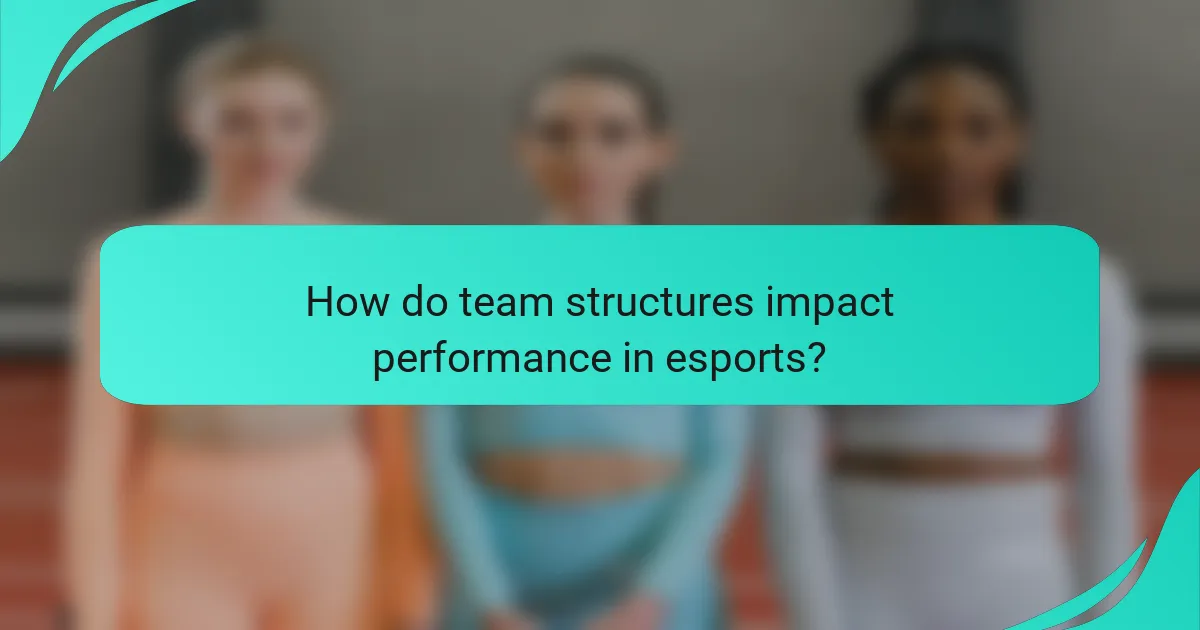Team structures in esports vary widely across different genres, shaped by unique game mechanics, player roles, and competitive formats. Recognizing these differences is essential for players and organizations to enhance their strategies and overall performance. By examining how specialized roles function within teams, stakeholders can better navigate the complexities of each game and adapt to evolving competitive landscapes.

How do team structures vary across popular esports genres?
Team structures in esports genres differ significantly based on game mechanics, player roles, and competitive formats. Understanding these variations is crucial for players and organizations aiming to optimize performance and strategy.
Team structures in League of Legends
In League of Legends, teams typically consist of five players, each assigned specific roles: top, jungle, mid, ADC (attack damage carry), and support. This structure emphasizes synergy and coordination, as players must work together to control objectives and secure victories.
Teams often utilize a coach and analyst to develop strategies and analyze opponents. Communication is key, and teams may practice various formations and tactics to adapt to different match scenarios.
Team structures in Dota 2
Dota 2 teams also consist of five players but feature more fluid roles, with positions often shifting based on the game’s needs. The common roles include offlaner, midlaner, carry, support, and hard support, allowing for diverse strategies and playstyles.
Coaches and analysts play a significant role in Dota 2, helping teams refine their strategies and improve in-game decision-making. The dynamic nature of the game requires teams to be adaptable and responsive to opponents’ tactics.
Team structures in Counter-Strike: Global Offensive
Counter-Strike: Global Offensive (CS:GO) teams typically consist of five players, with roles such as entry fragger, AWPer, support, lurker, and in-game leader. This structure focuses on tactical execution and teamwork, as players must communicate effectively to secure objectives and eliminate opponents.
Coaching staff is essential for developing strategies and improving team performance. Teams often analyze gameplay footage to identify strengths and weaknesses, refining their approach for future matches.
Team structures in Overwatch
Overwatch teams usually comprise six players, with a focus on diverse hero roles: tank, damage, and support. This structure encourages flexibility, as players may switch heroes during a match to adapt to the opposing team’s composition and strategies.
Coaches and analysts are vital for Overwatch teams, helping to devise strategies and improve team coordination. Effective communication and teamwork are crucial for success in this fast-paced game.
Team structures in Fortnite
Fortnite teams can vary in size, commonly featuring squads of four players. The game emphasizes individual skill and teamwork, with players taking on roles such as builder, shooter, and support to maximize their chances of victory.
While formal coaching structures are less common in Fortnite, players often analyze their gameplay and collaborate with others to improve strategies. Understanding the competitive landscape and adapting to evolving game mechanics is essential for success.

What are the key roles in esports team structures?
Esports team structures typically consist of various specialized roles that contribute to the overall success of the team. Understanding these roles is essential for both players and fans, as they determine how teams strategize and execute their gameplay.
Roles in League of Legends teams
In League of Legends, team roles are categorized into five main positions: Top, Jungle, Mid, ADC (Attack Damage Carry), and Support. Each role has distinct responsibilities; for instance, the Top laner focuses on solo lane control and tanking, while the ADC is crucial for dealing damage in team fights.
Effective communication and synergy among these roles are vital. A common pitfall is neglecting the importance of vision control, which the Support player typically manages. Teams should prioritize establishing map awareness to secure objectives and gain an advantage.
Roles in Dota 2 teams
Dota 2 features a more flexible role system, often categorized into five positions: Position 1 (Carry), Position 2 (Mid), Position 3 (Offlaner), Position 4 (Support), and Position 5 (Hard Support). Each position has unique objectives, with the Carry focusing on late-game scaling and the Offlaner disrupting enemy farm.
Coordination is key in Dota 2, as team fights can pivot on the execution of abilities. Teams should avoid overcommitting to fights without proper vision and positioning, as this can lead to significant losses. Understanding the strengths and weaknesses of each hero in relation to their roles can greatly enhance team performance.
Roles in CS:GO teams
In Counter-Strike: Global Offensive, team roles are generally divided into Entry Fragger, AWPer, Support, Lurker, and In-Game Leader (IGL). The Entry Fragger leads attacks, while the AWPer specializes in long-range engagements. The Support player provides utility and covers teammates.
Successful CS:GO teams often emphasize the importance of strategy and communication. A common mistake is failing to adapt roles based on map dynamics and opponent strategies. Teams should regularly review their gameplay to identify areas for improvement and ensure that each player is effectively fulfilling their role.

What factors influence team structure decisions in esports?
Team structure decisions in esports are influenced by various factors including game mechanics, player skill specialization, and regional competitive trends. Understanding these elements helps teams optimize their performance and adapt to the unique demands of each game genre.
Game mechanics and design
The mechanics and design of a game dictate how teams should be structured to succeed. For instance, games with complex strategies, like Dota 2, often require a diverse range of roles, such as carry, support, and offlaner, each with specific responsibilities. In contrast, fast-paced shooters like Counter-Strike: Global Offensive may benefit from a more streamlined approach, focusing on sharpshooters and entry fraggers.
Teams must analyze the game’s design to determine optimal compositions. For example, a game that emphasizes teamwork and communication might require players who excel in collaborative roles, while a title that rewards individual skill may prioritize star players capable of carrying games alone.
Player skill specialization
Player skill specialization is crucial in forming effective esports teams. Different games often necessitate distinct skill sets, leading to specialized roles such as sniper, healer, or tank. Teams should assess each player’s strengths and weaknesses to create a balanced roster that maximizes overall performance.
For example, in a battle royale game, having players who excel in different aspects—like scouting, combat, and strategy—can enhance a team’s chances of success. It’s essential to avoid overloading a team with similar skill sets, as this can lead to vulnerabilities against diverse opponents.
Regional competitive trends
Regional competitive trends significantly shape team structures in esports. Different regions may favor specific playstyles or strategies, influencing how teams are built. For instance, North American teams might emphasize individual skill, while European teams often focus on strategic teamwork and coordination.
Understanding these trends can help teams adapt their structures to compete effectively in various tournaments. Teams should monitor regional competitions and player movements to stay ahead of evolving strategies, ensuring they remain competitive in the global landscape.

How do team structures impact performance in esports?
Team structures significantly influence performance in esports by shaping communication, strategy, and overall synergy among players. A well-defined structure can enhance collaboration and adaptability, leading to better in-game decision-making and execution.
Impact on communication and synergy
Effective communication is crucial in esports, as it allows team members to share information quickly and coordinate their actions. Teams with clear roles and responsibilities often experience improved synergy, which can lead to more cohesive gameplay and better outcomes during matches.
For example, in team-based games like League of Legends, having designated shot-callers can streamline decision-making processes. This structure helps reduce confusion and ensures that all players are aligned with the team’s objectives, ultimately enhancing performance.
Impact on strategy and adaptability
Team structures also affect a team’s ability to develop and adapt strategies during competitions. A flexible structure allows teams to pivot quickly based on their opponents’ tactics, which is essential in fast-paced environments like Counter-Strike: Global Offensive.
Teams that regularly practice various strategies and maintain open communication channels can adjust their gameplay on the fly. This adaptability can be the difference between winning and losing, especially in high-stakes tournaments where opponents may employ unexpected tactics.

What are the emerging trends in esports team structures?
Emerging trends in esports team structures include the rise of hybrid roles and a growing emphasis on mental health. These shifts reflect the evolving dynamics of competitive gaming and the need for teams to adapt to new challenges and player well-being.
Rise of hybrid team roles
Hybrid team roles are becoming increasingly common in esports, where players take on multiple responsibilities rather than sticking to a single position. This flexibility allows teams to adapt strategies more fluidly during matches, enhancing overall performance. For example, a player traditionally focused on support may also engage in offensive tactics, creating unexpected advantages.
Teams are now structuring their rosters to include players who can switch roles based on the situation, which can lead to improved synergy and communication. However, this approach requires careful management to ensure that players are comfortable and skilled in their varied responsibilities.
Increased focus on mental health
There is a significant increase in the focus on mental health within esports teams, recognizing its critical role in player performance. Organizations are implementing support systems, such as mental health professionals and wellness programs, to help players cope with the pressures of competition. This trend is essential as the mental strain can impact not only individual players but also team dynamics.
Teams are encouraged to foster an environment where mental health is prioritized, which can lead to lower burnout rates and improved overall morale. Regular check-ins and open communication about mental well-being can help create a supportive atmosphere, allowing players to thrive both in and out of the game.

How can teams optimize their structures for success?
Teams can optimize their structures for success by implementing flexible roles, fostering communication, and adapting to the dynamics of their specific esports genre. This approach allows teams to respond quickly to challenges and leverage the strengths of individual players effectively.
Adopting flexible role assignments
Flexible role assignments enable players to adapt their responsibilities based on the team’s needs and the evolving game situation. This adaptability can enhance team performance, as players can switch roles to cover weaknesses or exploit opponents’ vulnerabilities.
For example, in a first-person shooter, a player typically designated as a sniper might take on a support role if the team requires more utility during a critical round. Teams should regularly assess player strengths and preferences to facilitate these transitions smoothly.
To implement flexible roles, establish clear communication protocols and encourage players to express their comfort levels with different positions. Avoid rigid role definitions that can limit a player’s potential and stifle team synergy. Regular practice sessions focusing on role-switching can also help build this adaptability.
